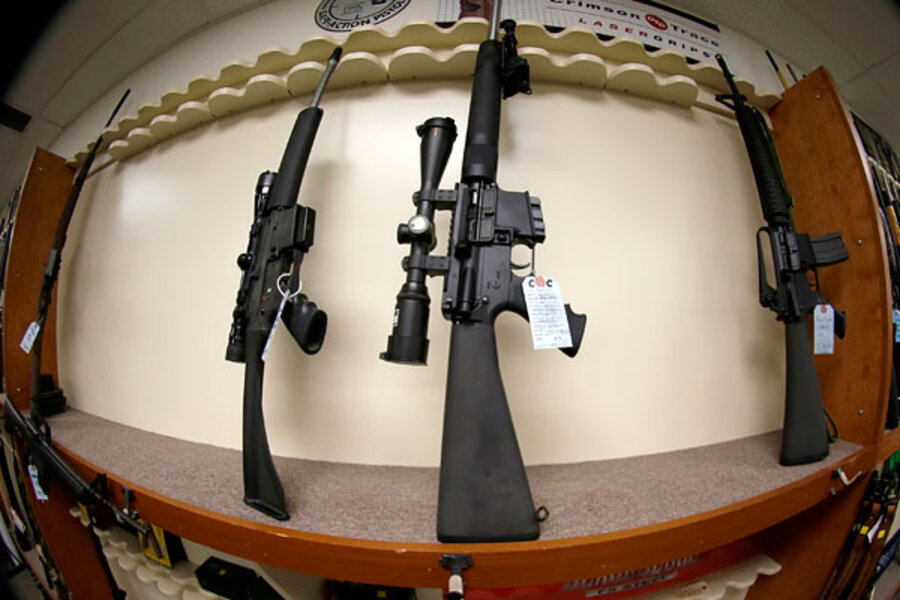Gun debate 101: How would this assault-weapons ban be different?
Loading...
Among other things, President Obama’s package of new gun-control proposals calls on Congress to reinstate the ban on assault weapons that was the law of the land from 1994 to 2004.
Such military-style rifles were the weapon of choice in the tragic shootings in both Aurora, Colo., and Newtown, Conn., the president pointed out. He said that their sole purpose is to “pump out as many bullets as possible, as quickly as possible,” and that they therefore have no place on the streets of America.
The proposed ban faces an uncertain future on Capitol Hill, however. Many lawmakers are leery about banning a particular class of firearm. Gun-rights proponents argue that “assault weapons” is a category based on appearance as much as capability.
So what is an assault weapon, anyway? Are they inherently more dangerous than, say, bolt-action hunting rifles? If they are so bad, why did Congress let the previous ban expire? Do they have any legitimate purpose?
Here’s a primer to try to outline some basics about these controversial yet commonly owned guns:
What's the definition of "assault weapon"?
Assault rifles are high-powered, small-caliber rifles (or pistols) styled to look as if they belong in the US Army’s arsenal. Military assault weapons such as the M16A2 function as fully automatic weapons, firing multiple bullets with one pull of the trigger. But civilian ownership of machine guns has been highly controlled in the US since the 1930s. Assault rifles available on the domestic market are semi-automatic, meaning one pull of the trigger fires one bullet, while the next round is chambered automatically and ready to go.
How would a ban work?
Semi-automatic weapons are very common, so that’s not the basis on which assault weapons would be banned. Instead, legislation controlling assault weapons would name specific firearm models, such as Bushmaster’s AR-15, as well as combinations of features to be outlawed.
Sen. Dianne Feinstein (D) of California was the author of the 1994 ban and has vowed to reintroduce an assault-weapons bill in the new Congress. A version of the bill she introduced in 2005 banned rifles known as AK-47s, AR-15s, and Uzis, among others. In addition, that legislation prohibited the ownership, transfer, or manufacture of any rifle that is capable of accepting a detachable magazine and has two or more of these five characteristics: a folding or telescoping stock, a pistol grip, a bayonet mount, a muzzle flash suppressor or threaded barrel capable of accepting such a suppressor, or a grenade launcher.
Does Obama want a ban that's tougher than the old one?
Yes. A White House fact sheet on the president’s gun proposals says the 1994 ban was a good start, but that manufacturers were able to circumvent it by making cosmetic modifications to their products.
“Congress must reinstate and strengthen the prohibition on assault weapons,” says the fact sheet.
Senator Feinstein has yet to release specific legislative language, but according to a summary of her proposed 2013 gun law posted on her website, she will move from a two-characteristic test to a one-characteristic test concerning what’s an assault weapon (see above). In addition, she would ban features known as “thumbhole stocks” and “bullet buttons.”
Thumbhole stocks are typical rifle stocks in which the manufacturer has drilled a hole so the user can hold it like a pistol for a better grip. Some hunters, particularly those who have served in the military, find this more comfortable and stable. But it could also facilitate one-handed use and spray-shooting from the hip – both of which can be used to target people, according to the Brady Campaign Against Gun Violence.
“Bullet buttons” are buttons that facilitate the quick removal of ammunition magazines with a pointed tool, such as a bullet. They are a way of getting around bans of quick-change magazines that can be removed with only the press of a finger.
Would the government confiscate existing assault weapons?
No. The ban would primarily affect the manufacture, sale, and transfer of new assault weapons. Both the White House and Feinstein say assault weapons already in private hands would remain legal. A similar provision in the 1994 legislation left untouched an estimated 1.5 million assault weapons in private ownership.
However, Feinstein’s summary of her proposed 2013 law says that it will call for these grandfathered weapons to be registered under the National Firearms Act, including a background check on current owners and any transferees. Feinstein has also said she may call for existing assault weapons to be secured via trigger locks.
Why did the old ban expire?
The short answer is that Congress and then-President George W. Bush let it expire. The longer answer is that there was little appetite among lawmakers to push for the extension of a law unpopular among gun owners given that assault weapons are used in a small percentage of gun crime. A 1997 survey of federal and state prisoners who had committed armed crimes found that less than 2 percent used an assault weapon.
In addition, at the time there were little data showing whether the number of people shot and killed with assault weapons declined during the period in which they were banned. Mr. Obama and gun control supporters say the national dynamics on this issue have now changed in the wake of the Aurora and Newtown tragedies.








